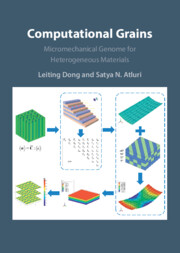Book contents
- Computational Grains
- Computational Grains
- Copyright page
- Contents
- Preface
- 1 Introduction
- 2 Computational Homogenization in the Micromechanics of Heterogeneous Materials
- 3 Direct Numerical Simulation of Materials Using Computational Grains
- 4 Trefftz Trial Functions for Computational Grains for Planar and 3D Problems
- 5 Computational Grains for Particulate Composites and Porous Materials
- 6 Computational Grains for Cylindrical Fiber Composites
- 7 Computational Grains for Nanocomposites
- 8 Computational Grains for Composites with Coated Inclusions
- 9 Computational Grains for Viscoelastic Composites
- 10 Computational Grains for Piezoelectric Composites/Porous Materials
- 11 Computational Grains with Embedded Microcracks in the Matrix and Inclusions
- 12 Multi-Scale Modeling of Composite Structures Using Computational Grains
- Index
- References
12 - Multi-Scale Modeling of Composite Structures Using Computational Grains
Published online by Cambridge University Press: 05 October 2023
- Computational Grains
- Computational Grains
- Copyright page
- Contents
- Preface
- 1 Introduction
- 2 Computational Homogenization in the Micromechanics of Heterogeneous Materials
- 3 Direct Numerical Simulation of Materials Using Computational Grains
- 4 Trefftz Trial Functions for Computational Grains for Planar and 3D Problems
- 5 Computational Grains for Particulate Composites and Porous Materials
- 6 Computational Grains for Cylindrical Fiber Composites
- 7 Computational Grains for Nanocomposites
- 8 Computational Grains for Composites with Coated Inclusions
- 9 Computational Grains for Viscoelastic Composites
- 10 Computational Grains for Piezoelectric Composites/Porous Materials
- 11 Computational Grains with Embedded Microcracks in the Matrix and Inclusions
- 12 Multi-Scale Modeling of Composite Structures Using Computational Grains
- Index
- References
Summary
The preprocessing of Computational Grains (CGs) is introduced in Chapter 3, and several types of CGs have been developed for the micromechanical modeling of different kinds of composites with particulates, fibers, and so on in Chapters 5–11. A multi-scale analysis framework of composite structures by using the CGs and the standard FEM is developed in this chapter, based on the homogenization of composite materials at the microlevel, and slender or shell structures at the meso- and macro-levels. The specific process of the multi-scale algorithm is illustrated with an example of a stiffened composite panel. The results show the multi-scale analysis method is an accurate and efficient tool for large composite structures, not only simulating the overall structural responses in a bottom-up fashion, but also obtaining the detailed stresses at multiple scales in the dehomogenization process.
Keywords
Information
- Type
- Chapter
- Information
- Computational GrainsMicromechanical Genome for Heterogeneous Materials, pp. 237 - 273Publisher: Cambridge University PressPrint publication year: 2023
